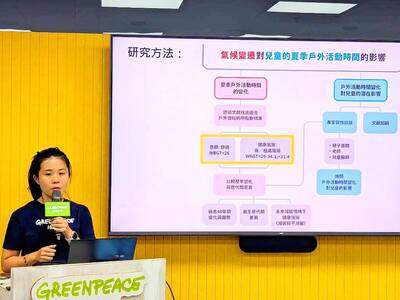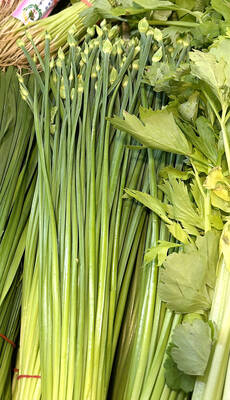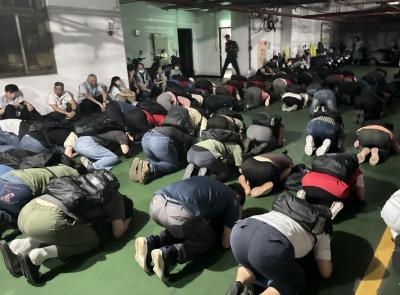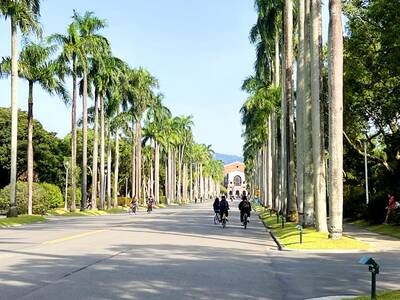Health experts yesterday warned parents to be aware of germs that could be lurking on their children's handkerchiefs.
According to a study released yesterday, a handkerchief used for more than one day can accumulate more than 100,000 bacteria.
The study, conducted among kindergarten children in Taipei City, was carried out by assistant professor Chen Yao-kuan (陳耀寬) of the Chao Yang University of Technology, a report in the Chinese-language paper, the United Evening News said.
According to the report, it said the study had found that 60 percent of the handkerchief samples tested were found to harbor colon bacillus and staphylococcus aureaus, bacteria that could cause diarrhea and skin infections.
Chen was quoted by the paper as saying that the amount of bacteria on a handkerchief that has been used for one day is three times as much as that found on a piece of two-day old meat.
"Handkerchiefs can accumulate a lot of bacteria when used to wipe away sweat or to clean hands, faces and mouths. A handkerchief used for one day is basically a piece of dirty cloth," Chen said, urging parents to be alert to the spread of enterovirus, a common illness in summer among young children.
He suggested disposable wet wipe tissues as the best alternatives to handkerchiefs to guarantee sanitation if handkerchiefs are not washed after a day's use.
Wet wipes can also guarantee good hand hygiene, he said.

The government should improve children’s outdoor spaces and accelerate carbon reduction programs, as the risk of heat-related injury due to high summer temperatures rises each year, Greenpeace told a news conference yesterday. Greenpeace examined summer temperatures in Taipei, New Taipei City, Taoyuan, Hsinchu City, Taichung, Tainan and Kaohsiung to determine the effects of high temperatures and climate change on children’s outdoor activities, citing data garnered by China Medical University, which defines a wet-bulb globe temperature (WBGT) of 29°C or higher as posing the risk of heat-related injury. According to the Central Weather Administration, WBGT, commonly referred to as the heat index, estimates

The Taipei Department of Health’s latest inspection of fresh fruit and vegetables sold in local markets revealed a 25 percent failure rate, with most contraventions involving excessive pesticide residues, while two durians were also found to contain heavy metal cadmium at levels exceeding safety limits. Health Food and Drug Division Director Lin Kuan-chen (林冠蓁) yesterday said the agency routinely conducts inspections of fresh produce sold at traditional markets, supermarkets, hypermarkets, retail outlets and restaurants, testing for pesticide residues and other harmful substances. In its most recent inspection, conducted in May, the department randomly collected 52 samples from various locations, with testing showing

Taipei and other northern cities are to host air-raid drills from 1:30pm to 2pm tomorrow as part of urban resilience drills held alongside the Han Kuang exercises, Taiwan’s largest annual military exercises. Taipei, New Taipei City, Keelung, Taoyuan, Yilan County, Hsinchu City and Hsinchu County are to hold the annual Wanan air defense exercise tomorrow, following similar drills held in central and southern Taiwan yesterday and today respectively. The Taipei Mass Rapid Transit (MRT) and Maokong Gondola are to run as usual, although stations and passenger parking lots would have an “entry only, no exit” policy once air raid sirens sound, Taipei

Taipei placed 14th in the Quacquarelli Symonds (QS) Best Student Cities 2026 list, its highest ever, according to results released yesterday. With an overall score of 89.1, the city climbed 12 places from the previous year, surpassing its previous best ranking of 17th in 2019. Taipei is “one of Asia’s leading higher-education hubs,” with strong employer activity scores and students “enjoying their experience of the city and often keen to stay after graduation,” a QS staff writer said. In addition to Taipei, Hsinchu (71st), Tainan (92nd), Taichung (113th) and Taoyuan (130th) also made QS’ list of the top 150 student cities. Hsinchu showed the